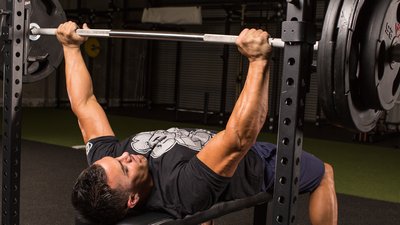One surefire way to big-time muscle gains is to target a muscle group and plan a strategy to make it significantly stronger. Want bigger legs? Add 100 pounds to your squat. Want a barn-door back? Build a huge deadlift. Want significantly larger pecs, front delts, and triceps? Build a big-ass bench press. There is an irrefutable relationship between dramatic increases in strength and dramatic increases in muscle size.
Elite powerlifters know this. They use planned periodization to stair-step strength upward in preparation for competition. Any gains in muscle size are secondary and purely coincidental. But not coincidentally, elite benchers have massive pecs, delts and triceps.
The logical leap for a muscle-seeking lifter, then, is to expropriate powerlifter tactics and grow a bigger bench in order grow bigger muscles. You can do it, but it will require a dramatic change from the way most people seek muscle.
Periodized Strength and Muscle Gains
The classic old-school powerlifting strength strategy is to sync up a 10- to 12-week pre-competition periodized training cycle with a purposeful increase in body weight. Powerlifters discovered long ago that by continually and conscientiously pushing their body weight upward during a periodized power cycle, they maximized results. The additional calories they took in over this time established anabolism, ignited muscle growth, and accelerated recovery. Each successive week, the powerlifter grows slightly larger and slightly stronger.
As a bodybuilder, you should focus your energy and effort toward a singular goal: dramatically increasing your bench press in 70 days, or 10 weeks. Religiously follow the approach below, and you can realistically expect to add 15-20 percent to your bench press in fewer than three months.

The caveat is that the gains are judged in relation to your best strict bench effort, not your best struggling-for-your-life rep. You'll establish a single-rep maximum at the beginning of the process to serves as a benchmark. Then you'll start building on it.
You'll Get Bigger, but It Won't Feel Like Bodybuilding
Over the next 10 weeks, you'll strip away all the exercise clutter and shift from a classic volume-biased bodybuilding training template into an intensity-biased powerlifting template. To improve the bench press, reduce the number of other chest (and arm) exercises performed to nothing more than press variations, dips, and a little extra triceps work specified in the program.
This will feel strange. The prototypical bodybuilder purposefully uses a wide repertoire of chest exercises in order to attack the muscle from a variety of angles. Arnold, at his peak, performed six chest exercises—32 sets done three times per week. His workouts epitomized volume training. Overall, Arnold performed 700 sets per week, spread over six double-split sessions.
By way of comparison, six-time IPF world champion Kirk Karwoski, a man with a 600-pound raw bench press weighing 270 pounds, performed a total of nine sets of flat bench press and five sets of incline bench presses just once a week. He performed a grand total of 60 sets per week for his entire body. His training was the epitome of minimalistic intensity training, and far closer to what you'll be doing here.
Your Technique Must Be Tight
If you're like the vast majority of recreational bodybuilders, you likely have been using a loose "touch and go" style of benching which creates momentum by rebounding the barbell off the chest. By contrast, powerlifters have to pause the barbell on their chest in competition. This is what you'll be doing.
Why? By being forced to pause, powerlifters build more muscle size, power, and raw strength for their respective effort than those practicing rebound benching. Rebounding creates momentum that enables the bencher to slide through the sticking points. Pausing forces the lifter to power through the sticking points without the aid of elastic energy.
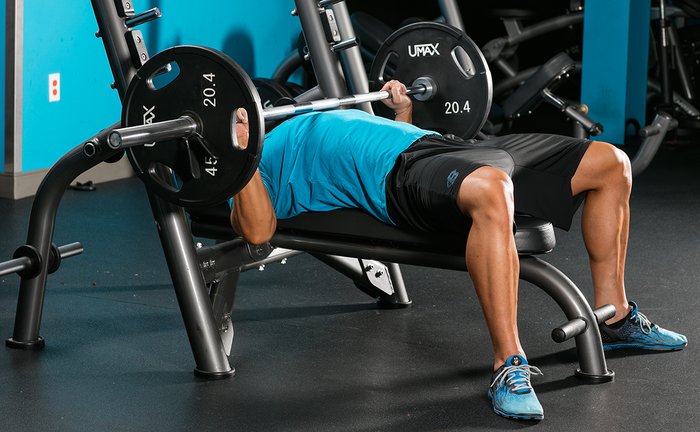
But there's a catch: While pauses are superior from a strength-infusing, muscle-building standpoint, they are exponentially more difficult. So consider yourself warned. Shifting from a looser, touch-and-go bench into a strict, paused bench style causes training poundage to plummet. This is an ego-buster of the first magnitude.
So while the weights may not feel elite, you're going to stick with elite technique. The elite bench presser doesn't avoid the sticking points; he or she seeks them out and battles through them, complete with controlled lowering and a hard lockout. Those sticking points are where the gains hide!
Advanced Benching Technique
- When encountering the sticking point, allow the bar to drift rearward, toward the top of your body.
- At the conclusion of every rep, contract your triceps hard, to lock out your elbows. Doing triceps work with hard lockouts is a great triceps builder, but it's more important for competitive powerlifters than bodybuilders, who more often favor soft lockouts.
- Resist the negative,regardless of whether you're using dumbbells or barbells. By resisting the negative, you build muscle; don't throw away all the incredible muscle-building attributes of a controlled negative. Bad benchers lower the bar fast and push up slowly; elite benchers lower slowly and push up explosively.
- When the program says "max reps," don't go all the way to failure. For this program, "max" is failure minus one rep. You rep until you cannot do another rep, but you do not need to—nor should you—actually fail with a bench press and miss the rep.
- Elite bench pressers use three distinctly different grip widths when flat benching. Each one augments the other. The power grip is slightly wider than shoulder width. For 80 percent of us, this will be your strongest bench-press grip width. The wide grip is one hand-width wider than the power grip. It builds starting strength off the chest. The narrow grip is one hand-width narrower than the power grip. Narrow-grip benching builds finishing lockout power.
- Use dumbbell bench presses to provide a great prestretch in the bottom position and make hard lockouts excruciating. The dumbbell bench actually has a narrower push pathway than narrow-grip bench presses.
- The optimal bench-press bar pathway is lowered in a slowed power arc down to the highest part of your chest; the bar or bells are paused on the maximally inflated, tense chest. The bar is then pressed upward in a gentle arc, up and back, a perfect mirroring of the lowering arc.
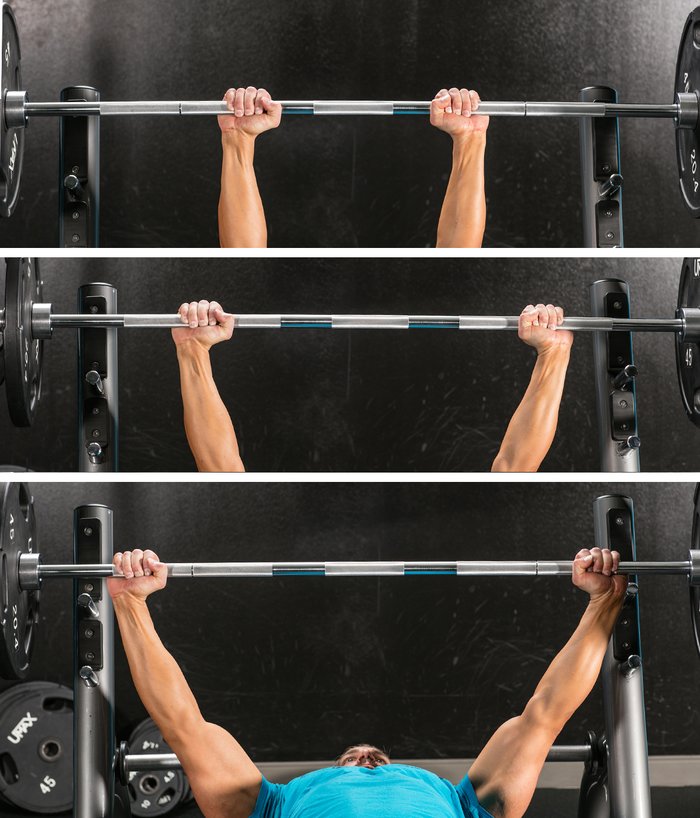
The bench-press program requires you to do benches with three different grips: close, power (medium), and wide.
The Program
During these 10 weeks, you'll bench on Monday and Thursday. Train legs on Tuesdays and back and biceps on Fridays. You'll take Wednesdays, Saturdays, and Sundays off from weight training. Because of the number of chest exercises, there is no additional shoulder work.
Identify your power-grip 1RM (max bench press, paused) at Week 1; you'll rely on that figure for all computations for all bench-press variations. The first three exercises—power grip, wide grip, and narrow grip—are done on Day 1. The fourth exercise, the dumbbell bench, is part of the Day 4 workout.
Note: Percentages of your 1RM increase from week to week (your 1RM remains the same), so that means the loads you'll be using change weekly. Refer to the charts below, computing your working weights based on your predetermined single-rep max. Follow the progressions below for the next 10 weeks with calculator in hand.
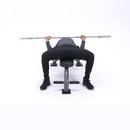
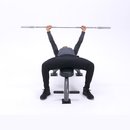

BodyFit
$6.99/month- 2,500+ expert-created single workouts
- 3,500+ how-to exercise videos
- Detailed workout instruction
- Step-by-step workout tips
- Training at gym or at home
- Access to Workout Plans
- Access to Bodyfit App
- Store Discounts
Already have a Bodybuilding.com account with BodyFit? Sign In

What comes with BodyFit?

- Instructional Videos
Don't risk doing a workout improperly! Avoid injury and keep your form in check with in-depth instructional videos.

- How-to Images
View our enormous library of workout photos and see exactly how each exercise should be done before you give it a shot.

- Step-by-Step Instructions
Quickly read through our step-by-step directions to ensure you're doing each workout correctly the first time, every time.
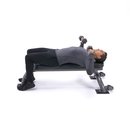
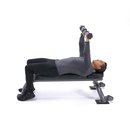

BodyFit
$6.99/month- 2,500+ expert-created single workouts
- 3,500+ how-to exercise videos
- Detailed workout instruction
- Step-by-step workout tips
- Training at gym or at home
- Access to Workout Plans
- Access to Bodyfit App
- Store Discounts
Already have a Bodybuilding.com account with BodyFit? Sign In

What comes with BodyFit?

- Instructional Videos
Don't risk doing a workout improperly! Avoid injury and keep your form in check with in-depth instructional videos.

- How-to Images
View our enormous library of workout photos and see exactly how each exercise should be done before you give it a shot.

- Step-by-Step Instructions
Quickly read through our step-by-step directions to ensure you're doing each workout correctly the first time, every time.
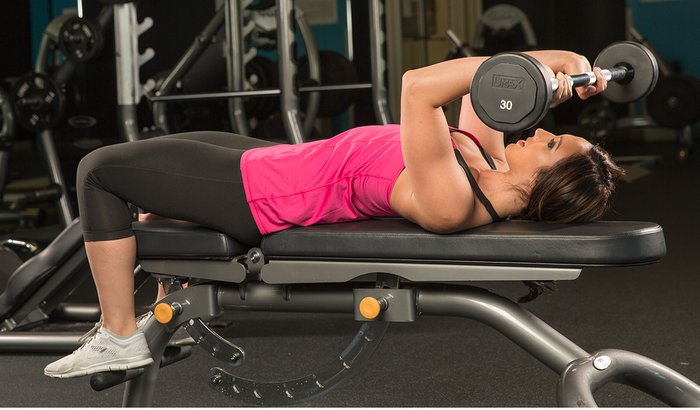
Lying Triceps Press
Example
Let's illustrate how to compute the working weights by way of an example of a man who can bench press 300 pounds with a short pause at the bottom, but who is still able to fully extend his arms at the top. He can do one and only one rep with good form at that weight. His one-rep max is 300 pounds.
All computations will be based off this figure. During Week 1:
- His power-grip bench is 75 percent of 300, or 225 pounds. He should do one working set (after warm-ups) for around 8 reps.
- His wide-grip bench press is also 75 percent of 300, or 225 pounds, but then he subtracts 20 pounds. He'll do one set of as many reps as possible with 205 pounds.
- His narrow-grip bench load is based off of what he did for the wide-grip bench – 205 pounds – but then he subtracts another 10. So he'll do one set of as many reps as possible with 195 pounds.
- His dumbbell weights for his alternate chest workout are a quarter of 300 pounds, or 75 for each dumbbell. He'll use that weight for two sets.
You'll need to similarly plug in your own 1RM to compute your working weights for each movement. Remember, percentages start to climb each week as will dumbbell weights, so make sure to keep track of what you're doing.


